Translate this page into:
Design and construction of prototype transversely excited atmospheric (TEA) nitrogen laser energized by a high voltage electrical discharge
*Corresponding author mukhussain@ksu.edu.sa (Mukhtar Hussain)
-
Received: ,
Accepted: ,
This article was originally published by Elsevier and was migrated to Scientific Scholar after the change of Publisher.
Available online 5 March 2015
Peer review under responsibility of King Saud University.
Abstract
The present study reports design and construction, of a prototype of Transversely Excited Atmospheric (TEA) nitrogen laser, and a high voltage power supply to excite N2 gas in air, while air is used as an active lasing medium. A Blumlein line discharge circuit is used for operation of this laser. The high voltage is generated by a fly back transformer based power supply varying from 10 kV to 20 kV. The wavelength (337.1 nm) of TEA nitrogen laser is measured employing a standard commercial spectrometer and the laser output energy of 300 μJ is measured from the constructed system. Different parameters such as beam profile, laser output spectrum, laser efficiency, and variation of E/P (Electrical field/Pressure) value with respect to input voltage and electrodes separations are studied in order to optimize the overall operational efficiency of present nitrogen laser. The analysis of the high voltage prototype appeared in this designed source has also been made and described in this paper.
Keywords
Laser
Nitrogen laser
TEA nitrogen laser
High voltage power supply
1 Introduction
A Transversely Excited Atmospheric (TEA) nitrogen laser is a pulse mode molecular gas laser. In this arrangement, the whole volume of the gas is excited with a single electric pulse (Silfvast, 1996). Normally, N2 gas or air is being used as an active medium in TEA nitrogen laser and lasing is obtained through electrical discharge of N2 gas or air between two specifically designed electrodes (Herden, 1975). A high potential difference has been obtained by an ignition system in the laser discharge channel creates a high electric field in the laser discharge channel which excites the nitrogen molecules due to fast pumping mechanism from the ground state to the Upper laser level C3Πu Population inversion has created between the upper laser level C3Πu and the lower laser level B3Πg by electron impact excitations. The laser transition occurs by emitting photons in ultraviolet (UV) region corresponding to the C3Πu → B3Πg transitions. The cross section for the electron impact excitations from the ground state to the upper laser level N2 (C3Πu) and lower laser level N2 (B3Πg), for the gain coefficients had been introduced and experimentally examined (Sarikhani and Hariri, 2010). The operation of nitrogen laser depends on a number of parameters and prerequisites like the applied voltage, spark gap, rate of gas flow, electric field to pressure ratio i.e. E/P, type of pre-ionization, length of active medium, inductance, laser discharge channel geometry and capacitances of capacitors. Since its birth many distinct features of nitrogen laser have been reported, including: pulse width, power output, effects of input power and gas flow mechanism, spectrum examination and measurement of output energies, spot size, electrode configuration, electrode spacing, spark gap properties, the ratio of C1/C2 capacitance of capacitors used in the Blumlein circuit, population inversion, lasing material, gain coefficient, output energy characteristics and fluorescence (Von Bergmann and Hasson, 1978; Vázquezmartínez and Aboites, 1993).
The first nitrogen laser operation was reported by Heard (1963), and the transversely excited atmospheric (TEA) nitrogen laser was introduced by Leonard (1965). Shipman (1967) used a parallel plate transmission line for transversely excitation of air. Generally, TEA nitrogen lasers operated at voltage in the ranges of 5–40 kV with the output energies from 40 to 370 μJ (Bergmann, 1977; Hasson et al., 1976; Santa et al., 1986; Schmidt et al., 1975; Suchard et al., 1975). Later, a miniature type of TEA nitrogen laser was also introduced employing 3 cm silicon electrodes operating at 5 kV and pulse energy of few μJ (Meisel and Langhoff, 1996). Recently, the inductive energy storage with the increased output energy per pulse was reported by Panchenko et al. (2009).
TEA nitrogen laser is a source of pulse light and it has been used to measure the speed of sound in different materials, to visualize the pulse plasma in nanosecond range was observed by Averin et al. (2004), applications in medicine (Provorov et al., 2005), determination of estrogens using surface assisted laser desorption (Chiu et al., 2008), nano particles based mass spectrometry for biomolecules analysis reported Chiang et al. (2011), deposition of thin films for nonlinear optical applications by El Ouazzani et al. (2012), characterization of phase change chalcogenide thin films (Alvi et al., 2013), crystallization of Te doped Ge–Se thin films has been done by Al-Agel (2014) with TEA nitrogen laser.
Here, we report a prototype TEA nitrogen laser design and a high voltage power supply to generate electrical discharge in air. The power source is based on flyback transformer with output voltage varying from 10 to 20 kV. In the present work, the TEA nitrogen laser electrodes are set to be used for traveling wave excitation in the transverse mode of operation. The transverse arrangement of electrodes has given preference over the longitudinal arrangement because of delivering high output power, efficient and faster voltage rise time. A free running spark gap (SG) has used for the triggering of the laser system that transfers the electrical energy into the laser channel, which excites the air molecules in a time scale of few nanosecond. We achieved the corona surface discharge by inserting a dielectric material between capacitor plates, keeping uniform gap between parallel plate capacitors and obtained a uniform glow discharge by clamping electrodes on the plates of capacitors just 2 mm at the height above the corona surface discharge. This design for the corona distance is considerably lower compared to designs reported earlier (Hariri et al., 1990; Sarikhani and Hariri, 2013).
2 Methods and materials
2.1 Design, construction and working of TEA N2 laser
The present TEA nitrogen laser design has based on Blumlein line discharge circuit as shown in Fig. 1, which is used to excite air within few nanoseconds in the laser discharge channel. In Fig. 2, the equivalent circuit of Blumlein design has shown. The present design consists of two parallel plate capacitors, C1 and C2 located on both sides of the laser discharge channel and connected through an inductor L. Both capacitors are charged and ignited through a spark gap which has connected to a high voltage power supply and C1 capacitor. One end of the spark gap has connected to one of the capacitor plate (C1) and other end to the common plate. As the spark gap has ignited, a traveling wave has been setup in one of the transmission lines, and gas discharge has started where it produces another traveling wave in the second electrodes. These two traveling waves superimpose and produce a high voltage which maintains the discharge in the laser discharge channel. To obtain a uniform discharge in the laser discharge channel, the impedance of the excitation system should be minimized. The impedance Z of the transmission line had been introduced (Crouch and Risk, 1972).
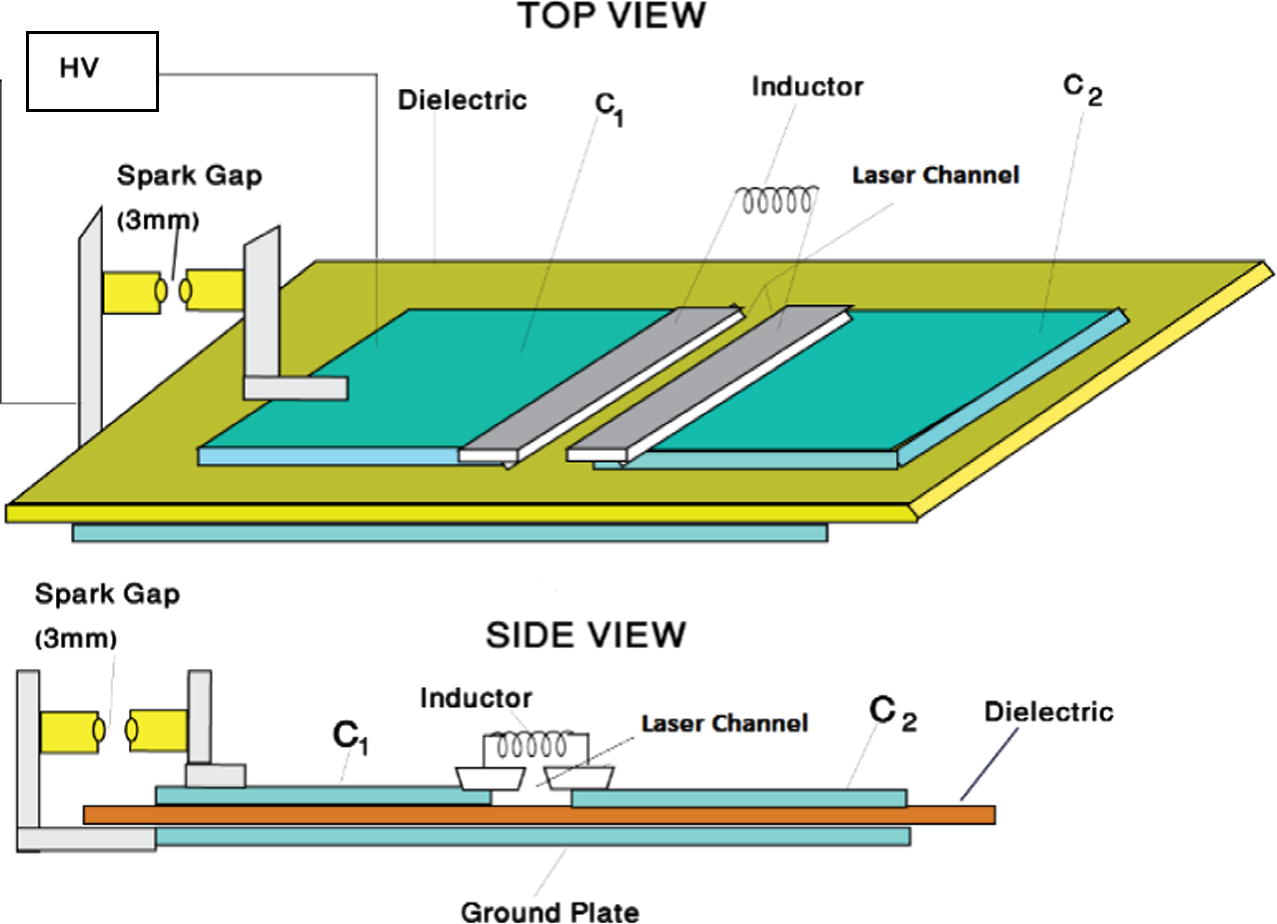
Schematic setup of TEA nitrogen laser.
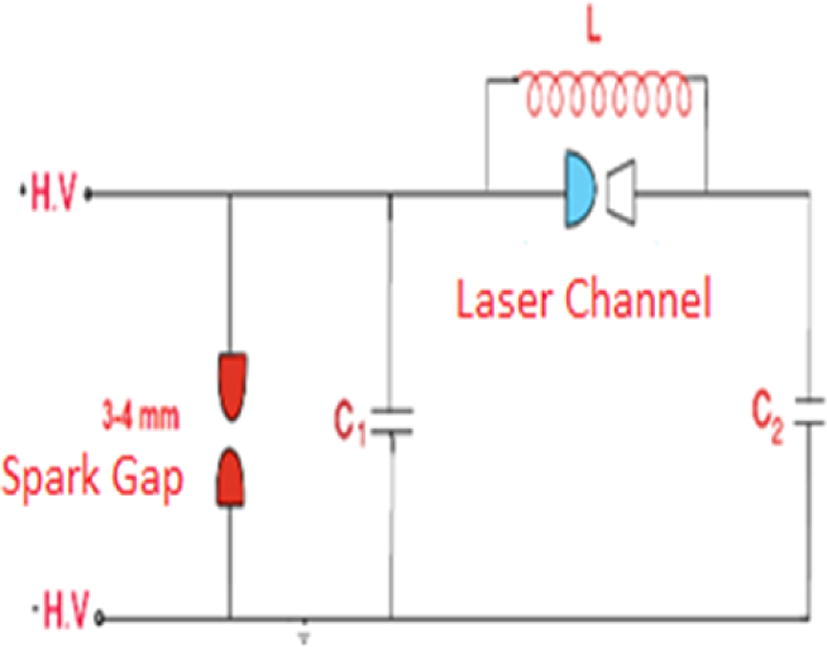
Equivalent Blumlein discharge circuit.
We used the material with the dielectric constant of 2.26, d is the separation between transmissions lines ∼0.1 mm, and w is width of the transmission line which is 34.0 cm. The impedance of the transmission line should be very low to obtain a uniform glow discharge in the laser discharge channel. The calculated value of the impedance of the transmission line is 0.067 Ω. The experimental setup has been divided into four parts, they are: capacitors, inductor, a spark gap and electrodes.
A transparency sheet of thickness 0.1 mm has sandwiched between the aluminum foil and two aluminum sheets of areas 754 cm2 and 606.97 cm2. This transparency sheet acts as a dielectric material with the dielectric constant of 2.26. This arrangement of aluminum sheets forms the parallel combination of two capacitors C1 and C2, whereas the capacitances of these capacitors are 15.08 nF and 12.14 nF, respectively. With this arrangement the total capacitance of this combination is 27.22 nF. Two aluminum electrodes are connected with the capacitors C1 and C2 and the space between the electrodes forms the laser discharge channel which has been designed in such a way to tolerate the effect of heating, high voltage and high peak current and ultraviolet radiations. The edges of the electrodes are aligned up to micrometer levels to get uniform discharge at atmospheric gas pressure. The gap separations between the electrodes at the back and front ends of laser discharge channel have been set to 1.4 mm and 1.5 mm, respectively to obtain uniform glow discharge in the laser discharge channel.
The two electrodes are connected with each other through an inductor L of length 9 cm having 32 turns with 2.35 cm of diameter. The inductance of this inductor is 5.58 μH, where it offers a low resistance for obtaining a fast electric discharge. The free running spark gap consists of two adjustable brass screws that are connected to capacitor C1. Both capacitors are charged simultaneously through an inductor L with prototype constructed high voltage power supply. When the applied voltage reaches to a level for the gas breakdown, the spark gap fires, the capacitor C1 discharges fully while the inductor imposes a high resistance to the rapidly changed voltage and does not allow the current to flow through inductor which keeps the capacitor C2 to stay in a highly charged state. Because of high voltage power supply, a high potential difference has developed between the electrodes which generate high electric field between two electrodes.
A rapid discharge occurs in air in the laser discharge channel because of the high electric field where it consequently leads to lasing in the UV regime. High voltage power supply has been used as a pump source for constructed TEA nitrogen laser and the free running spark gap has used as a triggering switch which shorts the circuit. The separation between the spark gap electrodes can be adjusted between 2 and 4 mm. If the gap of the spark gap is adjusted too large, the limit of storage voltage has exceeded the breakdown voltage of dielectric material and system fails to perform. If the gap is kept too small, then, the proper excitation of air molecules does not happen. Therefore, lasing cannot be achieved in this case. The most efficient lasing operation has been observed for a 3 mm gap of the spark gap for the reported system.
2.2 High voltage power supply
The circuit diagram of the high voltage power supply used in the present work is shown in Fig. 3. The design of the high voltage power supply consists of three stages, bridge rectifier and filter circuit to provide the +12 V dc voltage to operate timer circuit and the flyback transformer driver which is based on MOSFET.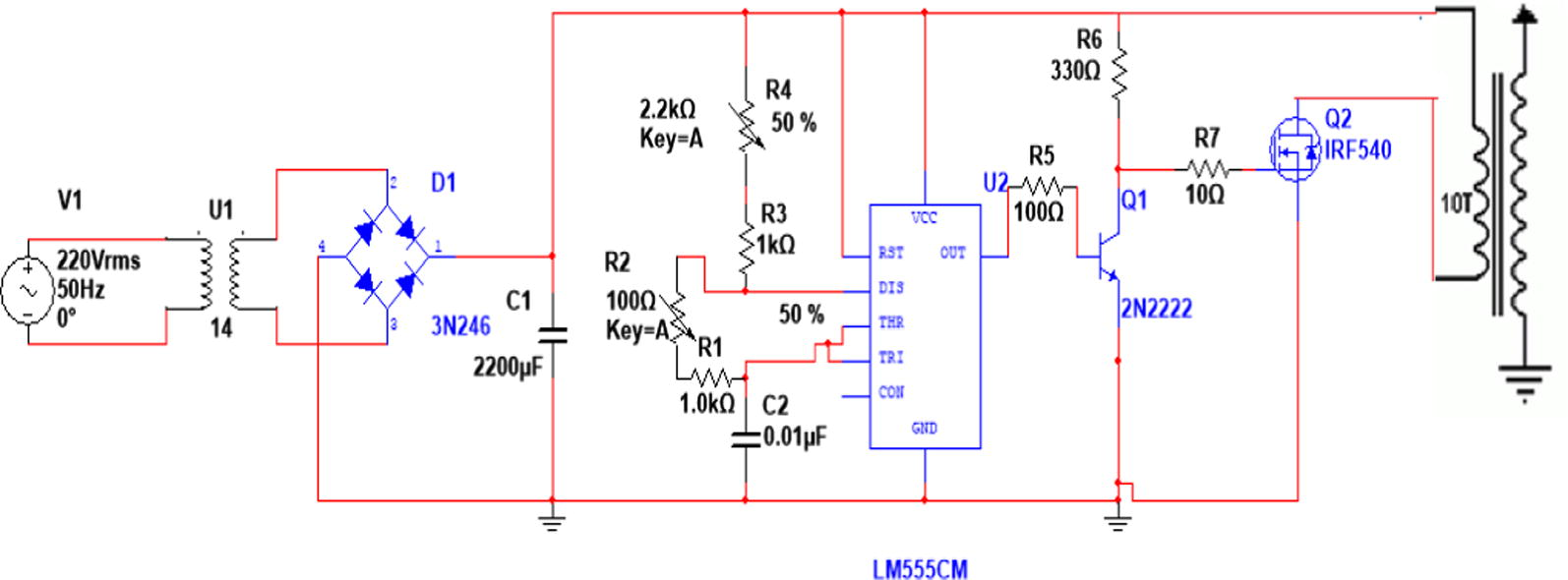
Circuit diagram of high voltage power supply.
The conventional bridge rectifier circuit consists of four silicon diodes to convert the alternating current to direct current, and the capacitor has been used as a filter for smoothing the direct current pulse waveform. This circuit should be able to provide +12 V dc at about 3 A. Major electronic components in the driver circuit are LM555CM, 2N2222 transistor, MOSFET IRF 540 along with the potentiometers, capacitor and resistances. C is the capacitance of the capacitor, which is 0.01 μF and l are potentiometers whose values can be varied from 1 to 10 kΩ.
3 Results and discussion
The frequency variation along LM555CM and MOSFET has been adjusted to obtain the required high voltage from the constructed prototype high voltage power supply. The output frequencies from LM555CM and MOSFET are dependent on resistance, when we adjust the values of R1 and R2 to 1.10 kΩ and 3.2 kΩ, respectively. The calculated output frequency of LM555CM is 19.23 kHz which is in a good agreement with the measured value, as shown in Fig. 4(a).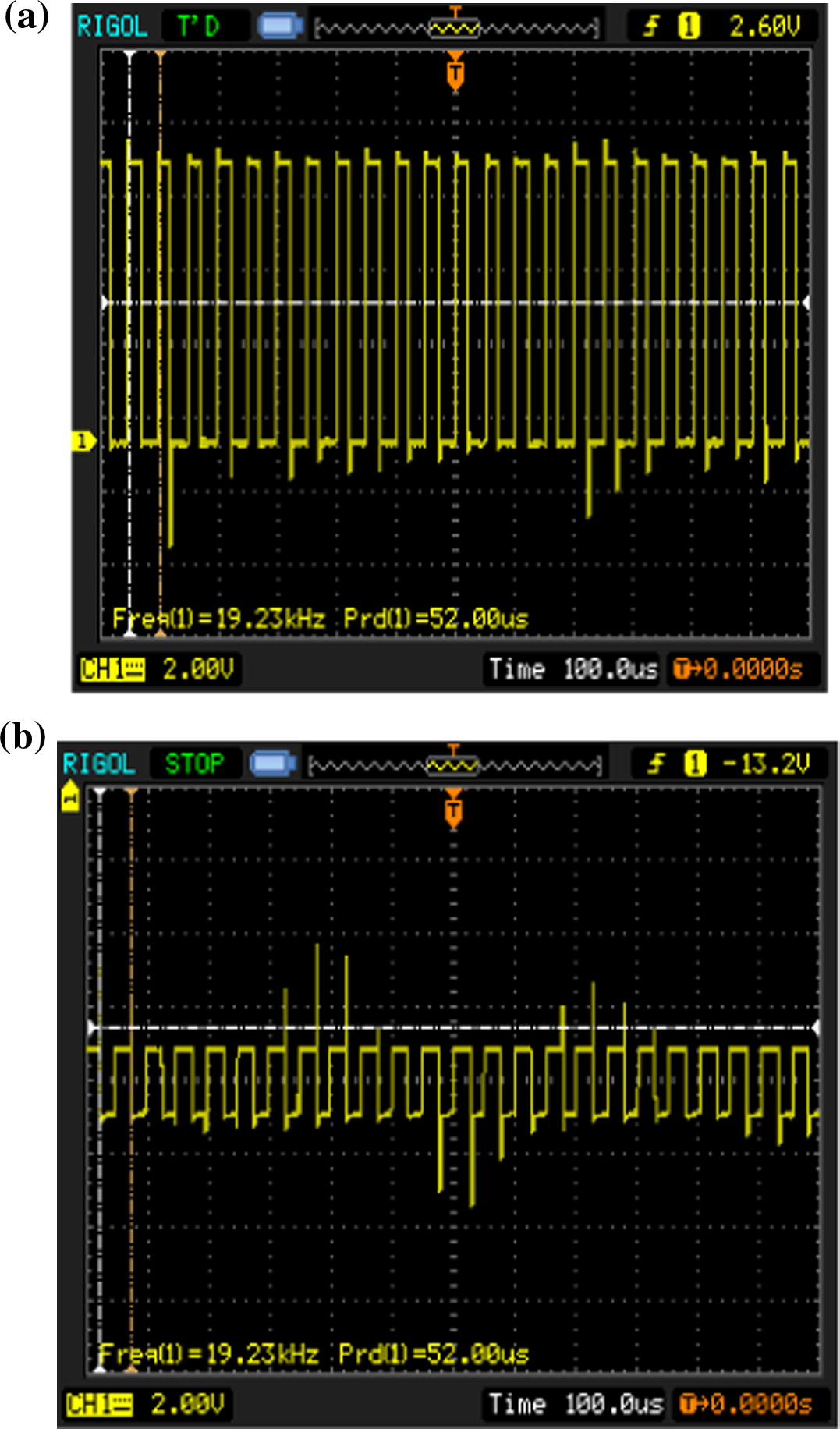
(a) Frequency output of LM555CM. (b) Frequency output of MOSFET.
The timer circuit has used LM555CM to pulse a transistor 2N2222 with a square wave at a frequency that has been set by the potentiometers R1 and R2. The transistor 2N2222, then, drives the gate of the MOSFET and the MOSFET delivers the pulse to the flyback transformer and ultimately high output voltage obtained across the secondary of the flyback transformer. We adjusted the potentiometers to achieve the highest possible voltage i.e. (10–20)kV. The output frequency from the LM555CM and MOSFET are well captured by a digital oscilloscope as shown in Fig. 4(b). It can be seen the pulse amplitude after the MOSFET decreased four time, but the frequency remains the same as generated by the LM555CM.
The output spectrum of laser beam has been measured by a standard spectrometer (Avantes, Inc.). The spectrum of the prototype TEA nitrogen laser system has shown in Fig. 5, which confirms that the peak wavelength of nitrogen laser occurs at 337.14 nm, and the full width at half maximum of the spectrum in this measurement has measured 1.0207 nm. The output beam profile of nitrogen laser has shown in Fig. 6. The beam spot is significant and produces more fluorescence if it has exposed to a white paper.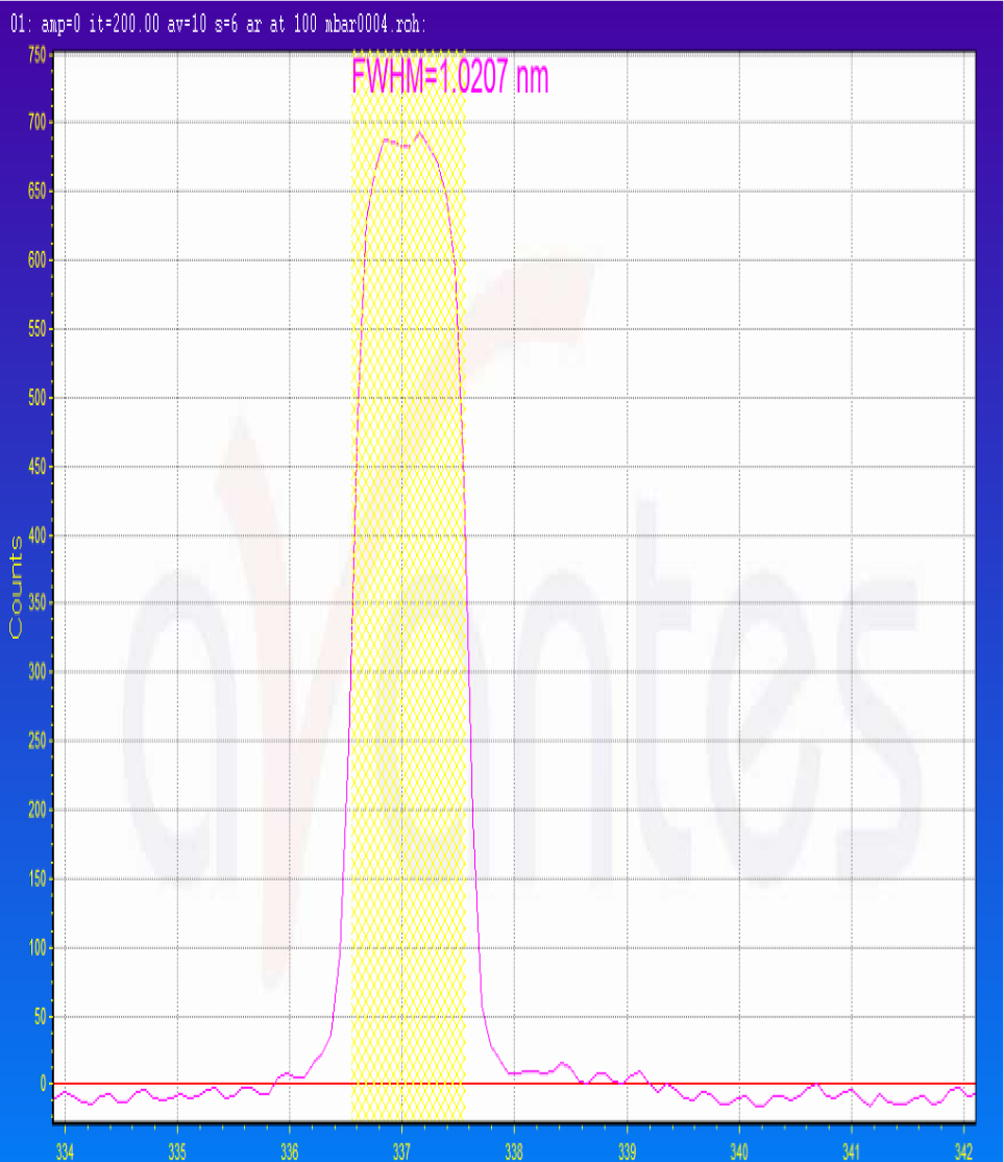
Spectrum of laser beam.
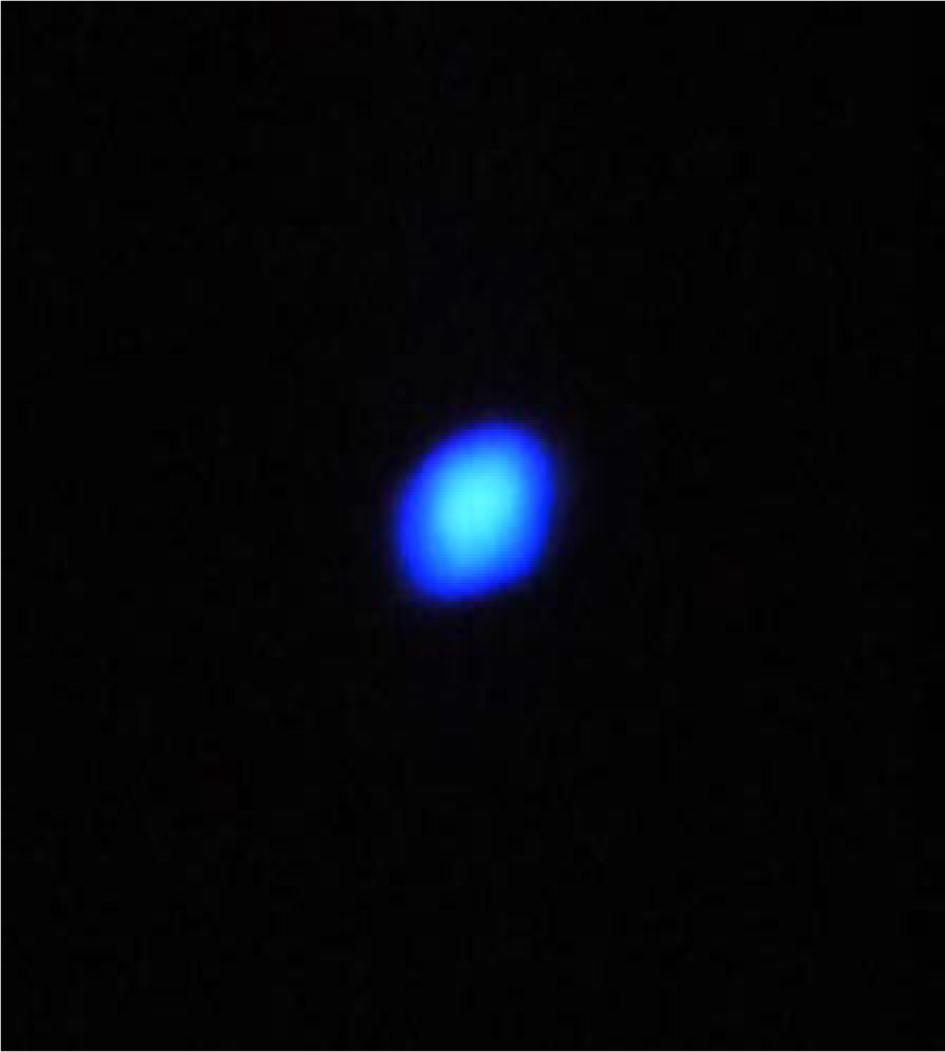
Beam spot on white paper.
To analyze the efficiency of the nitrogen laser, relations between the different parameters are studied. These parameters are: applied voltage, electric field between the electrodes in the laser discharge channel, and the gap separation in the spark gap. When the input voltage has set to 10 kV, with the electrodes separation adjusted to 1.4 mm, the calculated E/P value is 132.518 V/(cm.torr), while at 1.5 mm electrode separation the E/P value has been calculated 123.684 V/(cm.torr). The E/P value which is related to electron temperature Te (Sarikhani and Hariri, 2013) increases when the electrode separation decreases and also when the input voltage increases. The output pulse energy of 300 μJ has measured in the UV range at 337.1 nm. It has been observed that the peak power of this prototype TEA nitrogen laser increases with the increase of input voltage.
4 Conclusion
In this work, a TEA nitrogen laser of prototype has been designed and constructed based on Blumlein line discharge circuit and air in the laser discharge channel has been excited by a prototype constructed high voltage power supply. A uniform glow discharge has been achieved at considerably lower height above the surface corona discharge compared to the earlier reports. To optimize the efficiency of the TEA nitrogen laser, other parameters such as variation of the output power with respect to the input voltage, change of efficiency with the input voltage and the variation of E/P with the input voltage have been studied at different electrodes separations. Our observed and measured results of the present prototype TEA nitrogen laser has very much comparable to the published data of TEA nitrogen lasers.
Acknowledgments
The authors acknowledge this research was carried out at SBASSE-LUMS, Lahore, Pakistan. The authors would also like to greatly acknowledge the support of Dr. Muhammad Sabieh Anwar, Chairman Physics Department at SBASSE-LUMS, Pakistan.
References
- Structural and optical properties of Te doped Ge–Se phase-change thin films. A material for optical storage. Mater. Sci. Semicond. Process.. 2014;18:36-41.
- [Google Scholar]
- Characterization of phase change Ga< sub> 15</sub> Se< sub> 77</sub> Ag< sub>8</sub> chalcogenide thin films by laser-irradiation. J. Alloy. Compd.. 2013;550:431-437.
- [Google Scholar]
- A multichannel TEA N2 laser for visualizing pulsed plasma in the nanosecond range. Instrum. Exp. Tech.. 2004;47(2):209-213.
- [Google Scholar]
- Nanoparticle-based mass spectrometry for the analysis of biomolecules. Chem. Soc. Rev.. 2011;40(3):1269-1281.
- [Google Scholar]
- Determining estrogens using surface-assisted laser desorption/ionization mass spectrometry with silver nanoparticles as the matrix. J. Am. Soc. Mass Spectrom.. 2008;19(9):1343-1346.
- [Google Scholar]
- A compact high speed low impedance Blumlein line for high voltage pulse shaping. Rev. Sci. Instrum.. 1972;43(4)
- [Google Scholar]
- Novel styrylquinolinium dye thin films deposited by pulsed laser deposition for nonlinear optical applications. J. Phys. Chem. C. 2012;116(12):7144-7152.
- [Google Scholar]
- Corona-preconized nitrogen laser with variable pulse width. Rev. Sci. Instrum.. 1990;61:1408.
- [Google Scholar]
- Effective glow discharge excitation of nitrogen lasers at gas pressures ranging from 0 to 5 bar. Appl. Phys. Lett.. 1976;28(1):17-18.
- [Google Scholar]
- Compact high power sub-nanosecond nitrogen and open air lasers at 760 Torr. Phys. Lett. A. 1975;54:96-98.
- [Google Scholar]
- Saturation of the molecular nitrogen second positive laser transition. Appl. Phys. Lett.. 1965;7(1):4-6.
- [Google Scholar]
- Homogeneous high-pressure gas discharge using semiconductor electrodes. Appl. Phys. B. 1996;64(1):41-43.
- [Google Scholar]
- Laser on nitrogen–electronegative gas mixtures, pumped by inductive energy storage generator: experiment and theoretical model. Phys. Wave Phenomena. 2009;17(4):251-276.
- [Google Scholar]
- Pulsed gas lasers with longitudinal discharge and their application in medicine. Laser Phys.. 2005;15(9):1299.
- [Google Scholar]
- Experimental and theoretical investigation of a traveling wave excited TEA N2 laser. IEEE J. Quant. Electron.. 1986;22:2174.
- [Google Scholar]
- Nitrogen lasers: optical devices of variable gain coefficient: theoretical considerations. Opt. Commun.. 2010;283:118-127.
- [Google Scholar]
- Modification of nitrogen Townsend ionization coefficient in a N2 laser with a weak corona preionization and high gas pressure using laser output power measurement. J. Opt.. 2013;15 055705 (9pp)
- [Google Scholar]
- Interferometry using subnanosecond pulses from TEA nitrogen laser. Appl. Opt.. 1975;14:2250.
- [Google Scholar]
- Traveling wave excitation of high power gas lasers. Appl. Phys. Lett.. 1967;10(1):3-4.
- [Google Scholar]
- Laser Fundamentals. New York: Cambridge University Press; 1996.
- Quasi-cw laser emission from the second positive band of nitrogen. Appl. Phys. Lett.. 1975;26(9):521-523.
- [Google Scholar]
- Gain, fluorescence and energy extraction characteristics of photostabilised atmospheric pressure UV nitrogen lasers. J. Phys. D Appl. Phys.. 1978;11(17):2341.
- [Google Scholar]







